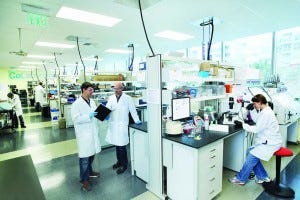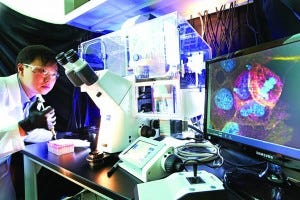Bridging Innovation and Partnerships in Mission Bay: Bayer's CoLaborator Program
December 11, 2014
Looking at the landscape today, it’s hard to believe that in 2004 the Mission Bay neighborhood of San Francisco, CA, was home to only two biotechnology companies. Over the past decade, industry-leading organizations across academia, clinical care, and research have settled in the area, creating a thriving ecosystem of more than 100 life science companies. Prestigious academic and research institutions such as The Gladstone Institutes and University of California San Francisco as well as life science accelerators such as QB3 are included in this lively biotech cluster.
As the third-largest biotech employer in the Bay Area, Bayer HealthCare recognized early on that establishing a presence in Mission Bay would allow for new synergies and encourage a culture of innovation. With this in mind, the company moved its research headquarters (the US Innovation Center) to Mission Bay in 2011. The goal was to optimize early stages of innovation and forge new early drug discovery alliances by leveraging core capabilities and onsite teams to investigate new disease indications. Largely as a result of this move, Bayer has been able to establish novel collaborations with academic and promising, early life-science startup companies. Through those collaborations, the company can apply its research expertise into new drug discovery fields and develop opportunities that will eventually improve Bayer’s pipeline.

Tenants work at Bayer’s first incubator for life-science startup companies
Expanding Role As an Inventor Company
Bayer HealthCare is not only committed to driving innovation from its own research, but also seeks to support novel research outside its facility. Both avenues are important because advancing a research idea from its formative early stages to a clinical application has become increasingly challenging. The aggregate cost of bringing a new product to market is currently estimated to be more than US$1 billion (1).
Under such formidable financial barriers, young biotech companies that are just starting to see initial successes in probing brand new therapeutic pathways or drug discovery tools have challenges of their own. Venture capital firms recently have been less willing to provide funding to the life sciences sector than they have in the past, given the high rate of failure in drug development and clinical trials. After moving to Mission Bay, Bayer became aware of an opportunity to develop early stage partnerships that extend beyond simply funding a project. The company now can establish deep collaborations between its own team of researchers and its partners. Developing that ability has required creative thinking and a shift from the traditional licensing model often used with later-stage assets.
Sharing Risks and Rewards
One important tenet of Bayer’s partnership model is a mutual expectation of shared risk and reward. Because early stage research alliances often are associated with high risk yet high reward, the company formulated shared-risk partnerships. Bayer often lends support through financing some of a project and/or offering resources of experienced research professionals and staff. Depending on the type of partnership, scientists from both the partner organization and Bayer may form a joint project team, so the human capital investment and research expertise is shared as well.
Bayer and its partners also align with complementary research goals and have a mutual expectation that research will eventually translate into therapies for patients. Through this
collaborative work, Bayer gains the opportunity to invest in a partner organization and expand its knowledge base. Partner organizations (particularly start-ups) can benefit by further validating their technology and positioning themselves for future partnering deals with Bayer and other organizations.
Flexibility is a key component of such an alliance formation strategy. Flexible agreements with early-stage partnerships establishes collaborations that range from extremely close interactions (e.g., joint laboratories or joint research teams) to “arm’s length” interactions in which companies or academic groups function completely independently from Bayer. Creative partnerships aim to share risks and rewards with both partners. To that end, Bayer’s CoLaborator program is the company’s latest offering: a strategic initiative established in Mission Bay.
A Short History of the Program
Given the backdrop of Mission Bay and its potential to tap into early stage research and innovation through “walking distance” collaborations, Bayer decided to launch its CoLaborator program in 2012. This is an important avenue for fostering growth and innovation biotechnology start-ups. The company saw a growing need for a laboratory incubator space for new biotech companies. Today, Bayer is at full capacity in its CoLaborator space, and other incubators in the Bay Area are finding a similar demand for such resources.
Located at Bayer’s US Innovation Center, the CoLaborator space offers an open laboratory layout and is designed for a quick start of research activities. The 6,000-ft2 facility aims to foster innovation by providing assigned laboratory bench and office space along with common research areas, shared laboratory equipment, and extended access to the Bayer research facilities when appropriate. CoLaborator companies also have access to non- Bayer neighborhood resources, such as UCSF’s imaging services.
With the exception of working spaces in close proximity, CoLaborator tenants are highly independent from Bayer. Renting the space allows those companies to function as separate entities. Bayer relies on the flexibility of “strategic leasing” as a way to work with companies that have promising technology but may not be immediately ready to partner. Whenever beneficial, Bayer and its tenant companies can develop further partnership agreements to maximize the benefits of colocation.
Aronora Inc., ProLynx LLC, and Xcell Biosciences were among the first round of tenants (see box), and all three have made substantial progress in just two years. Currently, seven new companies have a space in the CoLaborator area, and they have a wide array of research interests and goals that are aligned with Bayer’s. Overall, this investment in early stage research will benefit the wider patient community and in addition to supporting Bayer’s ongoing work in several therapeutic areas. The entrepreneurial spirit of early stage life science companies also has inspired Bayer’s scientists.
The First Colaborator TenantsAronora, Inc. (moved in September 2012, eight employees) is developing products for difficult-to-treat thrombotic blood- clotting diseases such as suspected or verified stroke, heart attack, pulmonary embolism, and severe infections. Bayer scientists provide support in Aronora’s preclinical product development efforts. In turn, Bayer is gaining expertise in the area of medical-emergency therapeutics.ProLynx LLC (moved in November 2012, nine employees) is developing a technology platform to overcome major limitations of releasable linkers currently used in drug conjugation. The technology uses sets of novel linkers that cleave at different, preprogrammed rates to allow for controlled, predictable, and sustained release of native, active drugs (peptides, proteins, and small molecules) from circulating and fixed macromolecular conjugates. Bayer plans to examine this technology as part of its Breakthrough Innovation program.Xcell Biosciences, Inc. (move In October 2013, five employees) develops primary cell culture technologies for patient-derived blood and tissue samples for research and the clinical applications. The company provides a standardized set of equipment, consumables, and protocols for easy primary cell culture across a number of cell types, including stem, neuronal, immune, and cancer cells. A key application for the platform is capture and coculture of immune and cancer cells from patient blood for the next generation of immune-oncology research and drug discovery. In 2014, Xcell conducted a pilot research study with Bayer Healthcare on pancreatic cancer cells examining Xcell’s technology ability to capture and cultivate tumor cells from blood samples of different cancer patients. Continued discussions with Bayer and Xcell will examine further collaborative projects to examine how Xcell’s technology could support Bayer’s oncology research programs. |

James Lim, CSO of Xcell Biosciences, works in Bayer Healthcare’s CoLaborator
Taking a Successful Model Global
After the success of its CoLaborator program in San Francisco, Bayer opened a second CoLaborator space in Berlin, Germany, in May 2014. Berlin has a thriving biotechnology culture and is home to one of Bayer’s main research sites. So it offered a synergistic combination of ecosystem and proximity to Bayer’s research team.
The CoLaborator model is clearly applicable in such locations, where the site is an independent building with 800 m2 located on the Bayer research campus. The Berlin CoLaborator site has space to house nine start-up companies. Its laboratory and offices promote collaboration and developments in life science technologies in a similar model to that in San Francisco. Bayer expects that its relationships with CoLaborator companies at both sites will continue to grow and expand — collaborating across continents, even as some companies outgrow the startup capacity of the CoLaborator facilities.
Furthering Innovation
The CoLaborator is just one of the many global strategies Bayer is using to engage with companies, academic research organizations, and clinical care centers. The company believes that such partnerships help support its continued role as an innovation company in research and development.
Bayer’s commitment to flexible partnerships means that relationships can range from traditional licensing to collaborative earlier stage models such as joint research, strategic alliances, and even shared laboratory space. In the end, whichever form a partnership takes must have the ability to capitalize on the strengths of both parties and create additional value allowing both parties to mutually share in the risks and rewards.
References
1 The Pharmaceutical Industry and Global Health: Facts and Figures 2012. International Federation of Pharmaceutical Manufacturers and Associations; www.ifpma.org/fileadmin/ content/Publication/2013/IFPMA_-_Facts_ And_Figures_2012_LowResSinglePage.pdf.
Chris Haskell is head of US Science hub at Bayer Healthcare, 800 Dwight Way, Building G4-314L, Berkeley, CA 94710; [email protected].
You May Also Like





